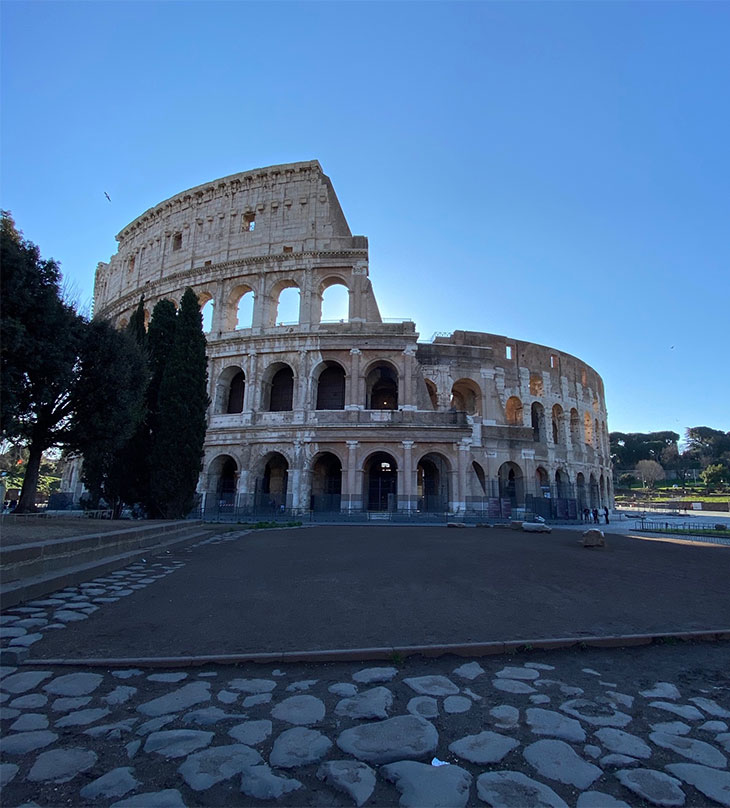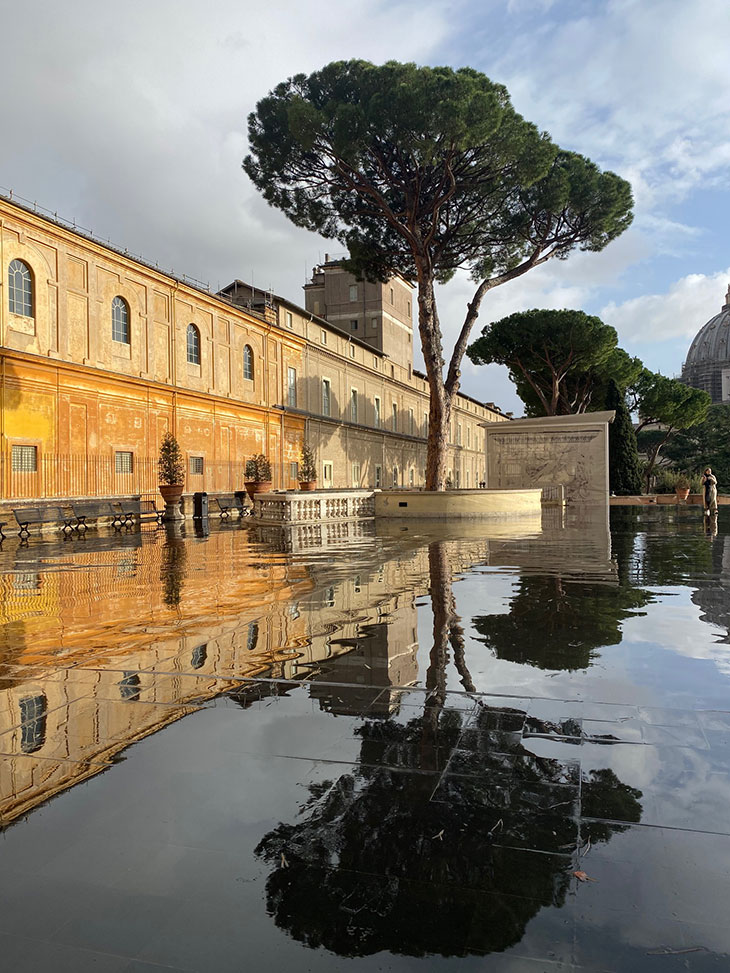The last week in Rome has been interminable. The emptiness of the city’s museums and archeological sites a week ago – 400 miles distant from the epicentre of the Covid-19 outbreak in Lombardy – was at first intriguing and curious. I work here as a private tour guide; last Monday, I took clients to the Colosseum and Forum, and we had them almost all to ourselves. I counted 12 other people in three hours. Given my suddenly empty diary, on Tuesday I went with friends to the Vatican Museums to admire the galleries and the Sistine Chapel in blissful and novel peace. On Wednesday, I took myself to the Borghese Gallery and had many rooms entirely to myself. I managed half of the excellent Raphael exhibition at the Scuderie del Quirinale on Thursday, the day it opened. On Friday, I walked past the usually teeming Trevi Fountain and Spanish Steps; the unfettered late baroque simultaneously timeless, magical, and eerie.

The Colosseum, Rome, on 8 March 2020. Photo: the author
While I was on the Palatine Hill on Sunday morning it was announced that all museums and archeological sites were closed until at least 3 April. On Monday evening, as I cooked dense pasta e fagioli (a siege dish if ever there was one), I happened to hear an announcement from the prime minister on the radio. Italy under quarantine: only journeys for essential reasons of work or health, and justifiable as such to the police, are to be made between towns and regions. All places of public gathering are closed, and all restaurants and coffee bars must limit numbers, maintain a metre distance between seats, and close at 6pm. You are allowed to leave your home for food shopping and solo exercise (thank heavens for Rome’s glorious parks) but should maintain distances of at least a metre from other people. No problem; on my walk through Villa Borghese on Tuesday morning there was plenty of space – just the occasional runner, and a few children on bicycles, squealing with excitement as they hurtled along empty paths.
This is what people have always dreamed of, isn’t it? The city stripped of hordes of jostling tourists, returned to ‘purity’. People (though tellingly rarely Romans) speak earnestly of the real Rome, before the money-grabbing rip-off joints, improbably coloured ice cream, and the tawdry souvenirs. However, as I wandered the deserted streets, it seemed to me that Rome without people isn’t really Rome at all. It’s always been a (the, Romans would say) destination for visitors, from the Republic onwards. Whether the journeys were voluntary or not, as the city grew it become a swirling melting pot of arrivals from across the empire: merchants, bureaucrats, soldiers, and slaves. The ever vaster monuments were to wow them, as well as the inhabitant populace.

Outside the Vatican Museums on 8 March 2020. Photo: the author
When the empire fell, these visitors were replaced with pilgrims, walking across the Alps or crossing seas, and arriving with sore and grubby feet to be presented with the unimaginable grandeur of the churches of the new Jerusalem. And they too were ripped off by rosary salesmen, money changers, and hawkers of relics. In Roman slang, a slightly bumpkinish person might be described as a pellegrino (from the Latin peregrinus, foreigner). It’s not said with malice: after all, it’s hardly their fault they’re ripe for the picking. Crowds and tat have always been part of the deal. It’s just the way it is. Romans know their city is the best city, for all they complain about it. It’s not a question of opinion, they just know.
Without visitors, this insouciant swagger – every much part of Rome’s fabric as the Colosseum, St Peter’s, or indeed the perpetual works of the Metro C – has been replaced with a listless confusion. Roads normally dense with traffic are empty. Vast numbers of people are out of work. On the deserted streets of the inner suburbs the lunchtime sounds of chinking crockery and cutlery can be heard, usually the preserve of sweltering summer Sundays, when anyone with any sense is at the coast or in the mountains. We are living a perpetual mid-August Sunday in early March. The enervating heat has been swapped for a murmuring undertone of anxiety, and it’s very odd indeed.

‘Rome without people isn’t really Rome at all’ – notes from a city under quarantine
A police officer standing guard in St Peter’s Square. Photo: Andreas Solaro/AFP via Getty Images
Share
The last week in Rome has been interminable. The emptiness of the city’s museums and archeological sites a week ago – 400 miles distant from the epicentre of the Covid-19 outbreak in Lombardy – was at first intriguing and curious. I work here as a private tour guide; last Monday, I took clients to the Colosseum and Forum, and we had them almost all to ourselves. I counted 12 other people in three hours. Given my suddenly empty diary, on Tuesday I went with friends to the Vatican Museums to admire the galleries and the Sistine Chapel in blissful and novel peace. On Wednesday, I took myself to the Borghese Gallery and had many rooms entirely to myself. I managed half of the excellent Raphael exhibition at the Scuderie del Quirinale on Thursday, the day it opened. On Friday, I walked past the usually teeming Trevi Fountain and Spanish Steps; the unfettered late baroque simultaneously timeless, magical, and eerie.
The Colosseum, Rome, on 8 March 2020. Photo: the author
While I was on the Palatine Hill on Sunday morning it was announced that all museums and archeological sites were closed until at least 3 April. On Monday evening, as I cooked dense pasta e fagioli (a siege dish if ever there was one), I happened to hear an announcement from the prime minister on the radio. Italy under quarantine: only journeys for essential reasons of work or health, and justifiable as such to the police, are to be made between towns and regions. All places of public gathering are closed, and all restaurants and coffee bars must limit numbers, maintain a metre distance between seats, and close at 6pm. You are allowed to leave your home for food shopping and solo exercise (thank heavens for Rome’s glorious parks) but should maintain distances of at least a metre from other people. No problem; on my walk through Villa Borghese on Tuesday morning there was plenty of space – just the occasional runner, and a few children on bicycles, squealing with excitement as they hurtled along empty paths.
This is what people have always dreamed of, isn’t it? The city stripped of hordes of jostling tourists, returned to ‘purity’. People (though tellingly rarely Romans) speak earnestly of the real Rome, before the money-grabbing rip-off joints, improbably coloured ice cream, and the tawdry souvenirs. However, as I wandered the deserted streets, it seemed to me that Rome without people isn’t really Rome at all. It’s always been a (the, Romans would say) destination for visitors, from the Republic onwards. Whether the journeys were voluntary or not, as the city grew it become a swirling melting pot of arrivals from across the empire: merchants, bureaucrats, soldiers, and slaves. The ever vaster monuments were to wow them, as well as the inhabitant populace.
Outside the Vatican Museums on 8 March 2020. Photo: the author
When the empire fell, these visitors were replaced with pilgrims, walking across the Alps or crossing seas, and arriving with sore and grubby feet to be presented with the unimaginable grandeur of the churches of the new Jerusalem. And they too were ripped off by rosary salesmen, money changers, and hawkers of relics. In Roman slang, a slightly bumpkinish person might be described as a pellegrino (from the Latin peregrinus, foreigner). It’s not said with malice: after all, it’s hardly their fault they’re ripe for the picking. Crowds and tat have always been part of the deal. It’s just the way it is. Romans know their city is the best city, for all they complain about it. It’s not a question of opinion, they just know.
Without visitors, this insouciant swagger – every much part of Rome’s fabric as the Colosseum, St Peter’s, or indeed the perpetual works of the Metro C – has been replaced with a listless confusion. Roads normally dense with traffic are empty. Vast numbers of people are out of work. On the deserted streets of the inner suburbs the lunchtime sounds of chinking crockery and cutlery can be heard, usually the preserve of sweltering summer Sundays, when anyone with any sense is at the coast or in the mountains. We are living a perpetual mid-August Sunday in early March. The enervating heat has been swapped for a murmuring undertone of anxiety, and it’s very odd indeed.
Unlimited access from just $16 every 3 months
Subscribe to get unlimited and exclusive access to the top art stories, interviews and exhibition reviews.
Share
Recommended for you
‘Now is the time to be smart’ – the Pinacoteca di Brera in a time of lockdown
Its doors may be closed, but Milan’s greatest gallery will find ways to keep working for the quarantined city, says director James Bradburne
The triumphant – but temporary – return of Raphael’s tapestries to the Sistine Chapel
For just one week the full set of surviving tapestries commissioned by Pope Leo X could be seen in their original setting
Don’t stand so close to me! Art in an age of contagion
Some scenes of art appreciation that wouldn’t pass muster in stricter viewing conditions